Chapter 10 – Disaster Management
1. Complete the table.
(Motor accident, landsliding, forest fire, theft, riot, war, epidemic, drought, locust attack, financial crisis, flood, famine)
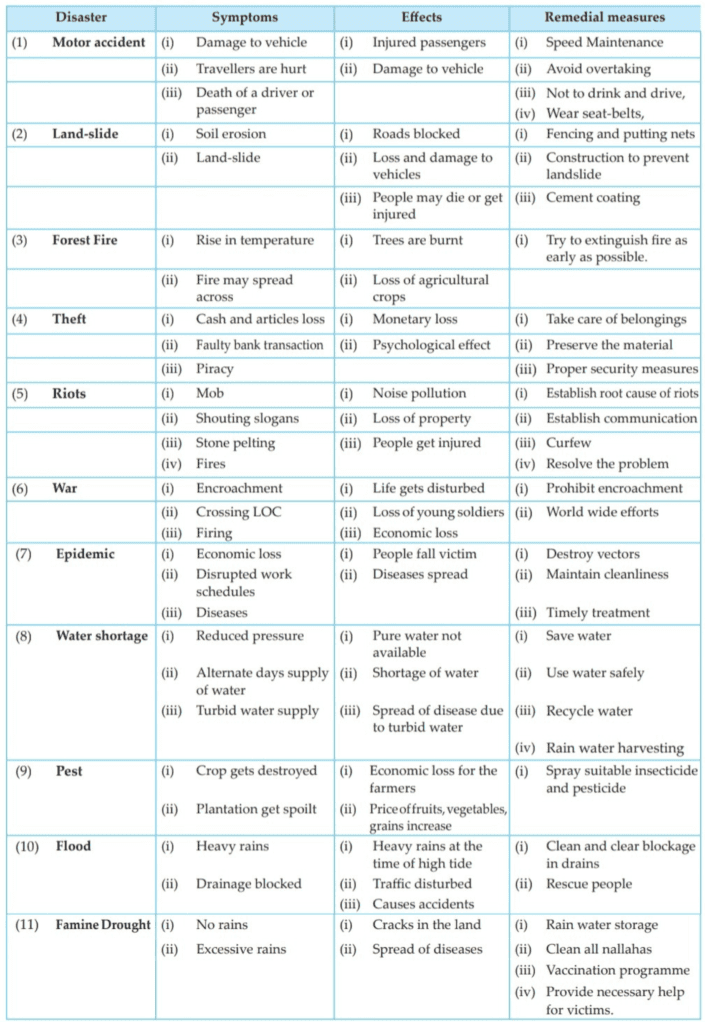
2. Write notes.
a. Disaster management Authority
Ans:
(i) In case of disaster management, there should be an attempt to minimize the losses.
(ii) Authority has been established at the level of the Government.
(iii) Disaster Management Act, 2005 has been passed in our country.
(iv) At the district level, the district collector is responsible for disaster management and implementation of rehabilitation schemes.
(v) Collector is responsible for planning, coordinating and controlling the implementation of the rehabilitation programme, gives out necessary instructions and reviews the entire system.
(vi) District collector is also responsible for designing the schemes for each district, separately for each type of disaster and getting those sanctioned from state level authorities.
(vii) District control unit is established immediately either after the impact of disaster or getting intimation about it. It receives information about various aspects of the disaster, keeps continuous contact with various agencies.
b. Nature of disaster management
Ans:
(i) Taking into consideration the nature and scope of disaster, three aspects of disaster are important for common citizens.
(a) Phase of emergency :
Important characteristic of this phase is that maximum lives can be saved by quick actions during this phase only. Various actions like search and rescue operations, medical assistance, first aid, restoring communication services, and removing the people from affected areas are expected in this phase. Gravity of disaster can be estimated in this phase only.
(b) Transitional phase :
Rehabilitation work starts in this phase, after subsidence of any type of disaster. It includes clearing of debris, restoring water supply, repairing roads etc. so that it helps to bring normalcy in public life.
(c) Reconstruction phase:
People reconstruct their buildings and facilities like roads and water supply are restored. Farming practices are restarted. However, it takes a long time for reconstruction.
c. Mock drill
Ans:
(i) Mock Drill is a practice to check the preparedness of facing a disaster as early as possible.
(ii) Virtual or apparent disasters are created to check the reaction time for any type of disaster.
(iii) Mock drill helps to check the efficiency of the system prepared for disaster redressal.
(iv) Mock Drill is observed and performed under trained personnel who check execution of plans designed for disaster redressal.
(v) It is arranged in various schools by the fire fighters to create awareness during fire.
(vi) It includes demonstrations like extinguishing fire, rescuing the people trapped at higher floors of buildings, rescuing the persons whose clothing have caught fire, etc.
(vii) Such activities are also organised by police forces and voluntary organizations.
d. Disaster Management Act, 2005
Ans:
(i) National Disaster Response Force has been established as per the Disaster Management Act 2005.
(ii) Divisions of these forces are working in the army.
(iii) Overall 12 divisions are working in the country.
(iv) Its headquarter is in Delhi and it is in action all over the country with the help of the army.
(v) In Maharashtra, the National Disaster Response Force is in action through the State Reserve Police Force.
(vi) Personnel of this force have substantial contribution in rescue work in disasters like cyclones, cliff-sliding, building collapse, etc.
3. Answer the following questions.
a. Explain the role of district disaster control unit after occurrence of any disaster.
Ans:
(i) At the district level, the district collector is responsible for disaster management and implementation of rehabilitation schemes.
(ii) District control units are established immediately either after the impact of a disaster or getting information about it.
(iii) It reviews various aspects of disaster, keeps continuous contact with various agencies like army, airforce, navy, telecommunication department, paramilitary forces etc. for getting help.
(iv) It is also responsible for coordinating with various voluntary organizations for their help in disaster management.
(v) It tries to establish the normal condition and proper rehabilitation as early as possible.
b. Give the reasons for increase in human disasters after the World War-II.
Ans:
(i) Planet Earth has experienced many natural disasters.
(ii) Most of the disasters are unpredictable situations that have occurred in the Asian continent and the regions of the Pacific ocean.
(iii) In reality, previous problems of several years have been fierce.
(iv) Due to population explosion, the basic needs have increased after World War -II.
(v) Conditions of instability arise in the country due to various reasons like economic inequality, racial and religious differences etc.
(vi) Incidents like terrorism, abduction, social differences have been a routine now.
(vii) Nuclear testing is being done by many countries and use of Nuclear energy has increased resulting in climatic changes.
c. Which are the objectives of disaster management?
Ans: Objectives of disaster managements are as follows:
(i) To minimize the loss of life caused during the disaster and to save people from those disasters.
(ii) To supply essential commodities to the affected people to reduce the impact of disaster.
(iii) To rehabilitate the affected people to get back to their normal life.
(iv) To take precautionary measures to avoid the future occurrence of the disaster.
d. Why is it essential to get the training of first aid?
Ans:
(i) The first-aid training is extremely necessary for every citizen.
(ii) Use of this knowledge is useful for offering help to the people around facing any disaster and injury.
(iii) The first-aid measures differ from person to person according to the type and intensity of disaster.
(iv) Victims of disaster need to be offered some primary help before actual medical treatment. First aid is useful in such circumstances.
(v) First aid training can help in saving life in actual disaster time.
(vi) First aid training helps people to face disaster with courage, maintain their morale and give psychological support, which can be provided to them by the people trained in first aid.
e. Which different methods are used for transportation of patients? Why?
Ans: For the transportation of patients following methods are used:
(i) Cradle method: This method is used for children and persons with less weight.
(ii) Carrying piggyback: This method is useful in carrying the unconscious persons.
(iii) Human crutch method: If one leg of the person is injured, then the victim is supported with minimum load on the other leg. This is called the human crutch method.
(iv) Pulling or lifting method: For carrying an unconscious person for a short distance this method is used.
(v) Carrying on a four-hand chair: This method is used when the support is needed for a part below the waist region.
(vi) Carrying on a two-hand chair: Patients that cannot use their hands but can hold their body upright, are carried by such a method.
(vii) Stretcher: By making a temporary stretcher in case of emergency, the unconscious patient can be moved. Such temporary stretchers are made by using bamboo, blankets, etc.
4. On the basis of the structure of disaster-management authority, form the same for your school.
Ans:
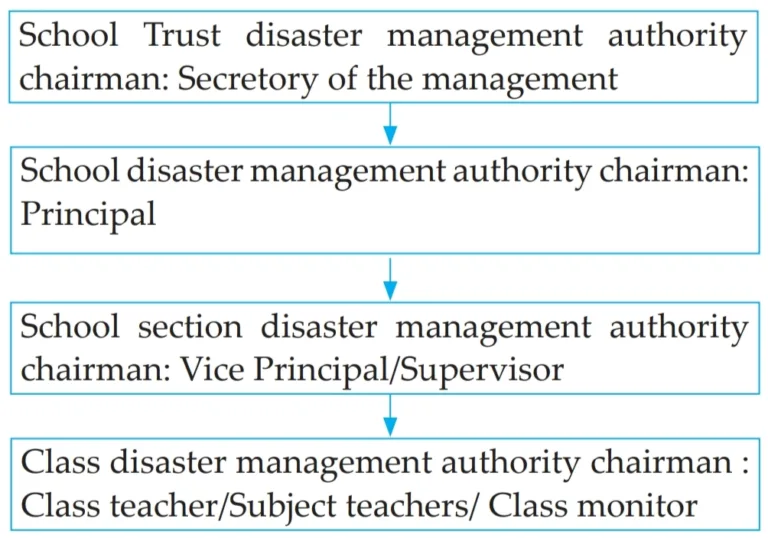
5. Write down the reasons, effects and remedial measures taken for any two disasters experienced by you.
Ans:
(1) Disaster 1: Bus fell from the overbridge into the flowing river.
Causes:
(i) The bridge had become weak.
(ii) The bridge was not repaired earlier despite the threat of falling down.
(iii) The driver was driving the bus at a reckless speed and so he lost control over it.
Effects:
(i) Some passengers died, drowned and some of them were severely injured.
(ii) The wall of the bridge got damaged.
Remedial Measures:
(i) Villages residing near the river rushed for help.
(ii) Survivors were given first aid immediately and were rushed to near-by hospitals.
(iii) The Collector, social organizations came to the accident spot and provided help.
(2) Disaster 2: Accident of a four wheeler on the road.
Causes:
(i) Overspeeding of the vehicle.
(ii) Driver was talking on his cellphone while driving and suddenly lost control over the vehicle.
Effects:
(i) Persons in the vehicle got severely hurt.
(ii) Driver died on the spot.
(iii) Passengers did not use seat-belt, hence the injuries were severe.
(iv) Vehicle caught fire after banging on the nearby shop.
Remedial Measures:
(i) Victims were immediately taken in an ambulance to a nearby hospital after providing first aid.
(ii) Police were informed.
6. Which different aspects of disaster management would you check for your school? Why?
Ans: Following are the things that can be checked:
(i) First aid box to provide first aid to victims of injuries.
(ii) Fire extinguisher to extinguish fire in case of emergency.
(iii) Source of pure water for drinking if people are stuck up.
(iv) Stretcher and Wheel chair to carry children to hospital.
(v) Emergency exits are clear for evacuation in case of any disaster.
(vi) Practice of Mock Drills at regular intervals.
(vii) Emergency numbers to be on every floor and easily visible.
7. Identify the type of disaster.
a. Terrorism
Ans: Man-made disaster.
b. Soil erosion
Ans: Geophysical disaster.
c. Hepatitis
Ans: Biological disaster.
d. Forest fire
Ans: Biological disaster.
e. Famine
Ans: Geophysical disaster.
f. Theft
Ans: Man-made disaster.
8. Some symbols are given below. Explain those symbols. Which disasters may occur if those symbols are ignored?
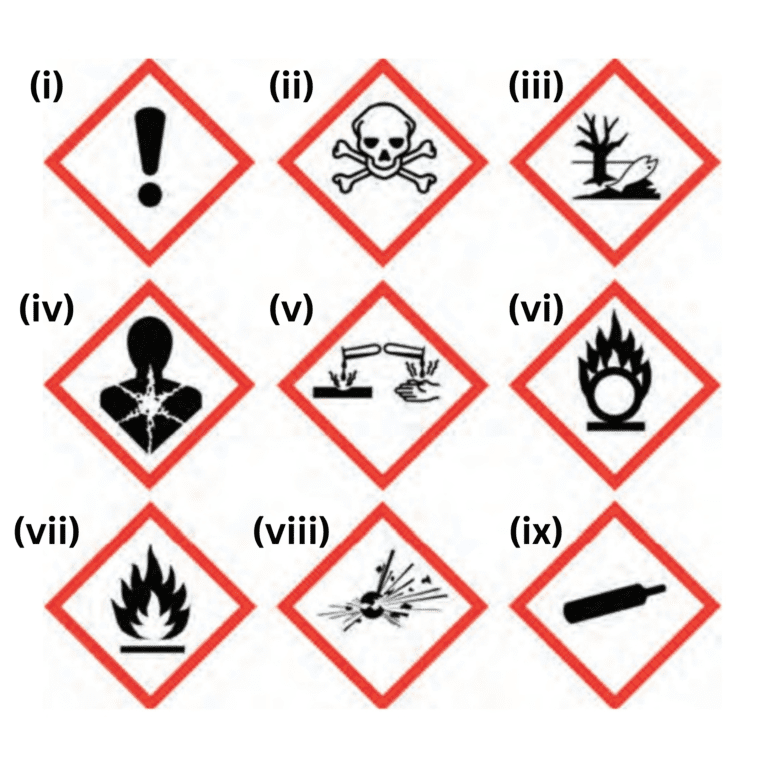
Ans:
(i) Toxic or irritant: If toxic or harmful chemical or gas is carried through cylinders. If ignored can cause leakage and lead to severe damage.
(ii) Danger: If there is a danger to life, this symbol is used. If ignored, it can cause loss of life.
(iii) Harmful for aquatic life: Chemical effluents if left in water can cause loss of aquatic life.
(iv) Dangerous for health: Specially for tobacco and alcohol. If ignored, it can cause cancer.
(v) Material causing skin corrosion / burns: Corrosive to metals. If ignored can cause skin corrosion.
(vi) Oxidiser: Contact can cause damage to metals.
(vii) Inflammable: If any highly inflammable material is carried through a vehicle, then this tag is used. If ignored, it can cause fire.
(viii) Explosive material: If a vehicle is carrying explosive material then this symbol is used. If ignored, it can cause an explosion.
(ix) Gas is stored under pressure: If ignored can cause gas leakage and damage.
9. Explain that why is it said like that?
A] Mock drill is useful
Ans:
(i) Mock Drill is a practice to check the preparedness of facing a disaster as early as possible.
(ii) Virtual or apparent disasters are created to check the reaction time for any type of disaster.
(iii) Mock drill helps to check the efficiency of the system prepared for disaster redressal.
(iv) Mock Drill is observed and performed under trained personnel who check execution of plans designed for disaster redressal.
(v) It is arranged in various schools by the fire fighters to create awareness during fire.
(vi) It includes demonstrations like extinguishing fire, rescuing the people trapped at higher floors of buildings, rescuing the persons whose clothing have caught fire, etc.
(vii) Such activities are also organised by police forces and voluntary organizations.
B] Effective disaster management makes us well prepared for future.
Ans:
(i) Disaster Management is achieving or from time to time improving the ability to face the disasters through scientific and careful observations and analysis of data.
(ii) It involves collecting the information about intensity of disaster and probable sites of disaster through predictive intensity maps and hazard maps respectively.
(iii) It also includes getting special training for disaster management.
(iv) Preparedness is a plan chalked out so as to get a quick response from the general public and administration.
10. Complete the following chart.
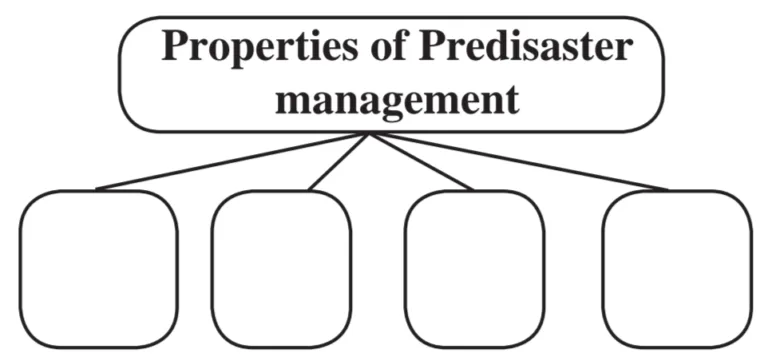
Ans:
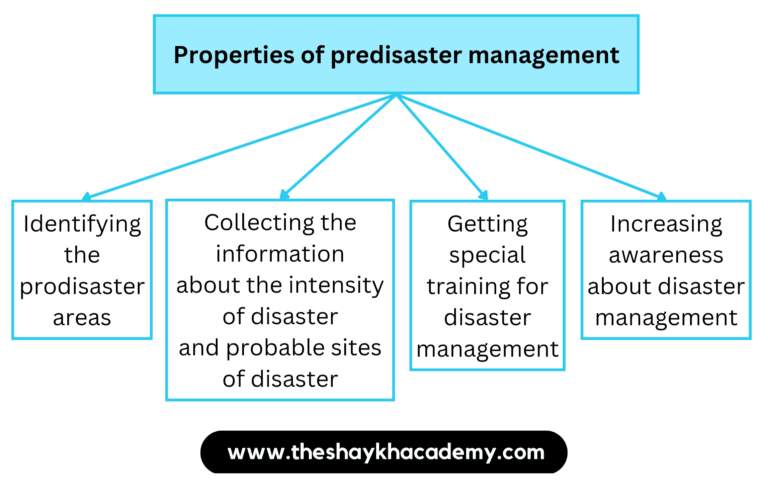
11. Following are the pictures of some disasters. How will be your pre- and post-disaster management in case you face any of those disasters?
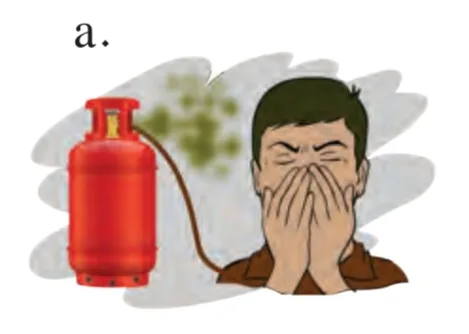
Ans:
(i) The disaster is a leakage of cooking cylinder gas.
(ii) This may cause suffocation, difficulty in breathing and can lead to fire.
(iii) Open the door and windows, switch off the electric supply and close the cylinder knob.
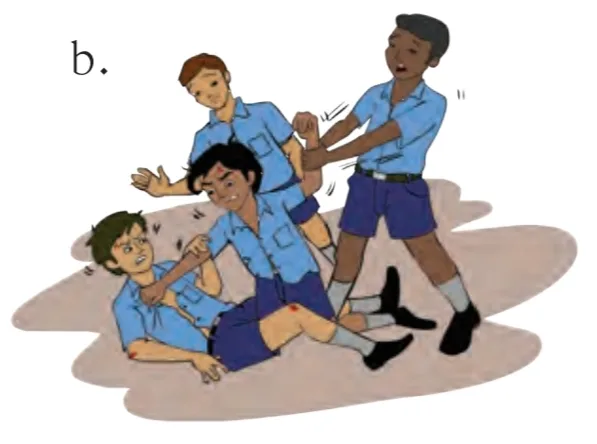
Ans:
(i) Here the disaster is fighting between children.
(ii) There may be abusive language used and can lead to noise pollution. Also, it can lead to serious injuries.
(iii) We will stop them immediately and separate them.
(iv) Understand the root cause of the quarrel and guide them accordingly.
(v) We will try to explain to them the importance of friendship.
(vi) If anybody is hurt, first aid should be provided.
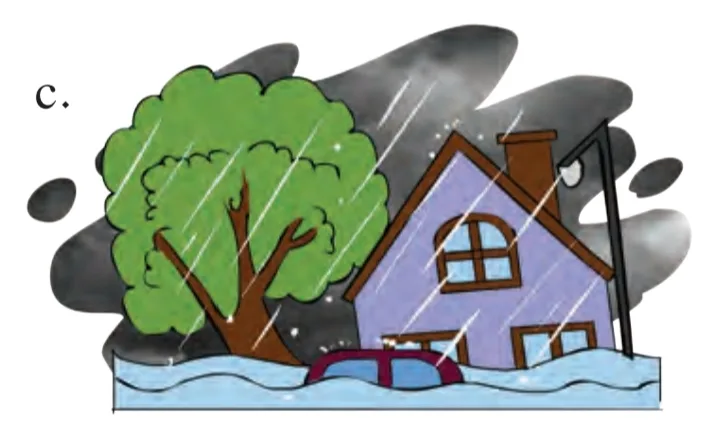
Ans:
(i) The disaster here is heavy rains and flooding.
(ii) To prevent water logging we should keep manholes open for drainage.
(iii) Rescuing people from the water logged areas by using ropes, boats etc.
(iv) Temporary shelter should be given to affected people. Essential commodities should be provided.
(v) Electric supply should be restored at the earliest.
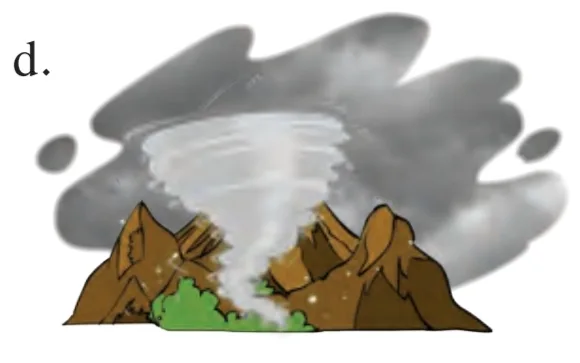
Ans:
(i) The disaster is a ‘Cyclone’
(ii) Forecast of the approaching cyclone can be helpful in evacuating the main areas of the disaster.
(iii) There may be incidents of uprooting of trees, building collapse etc.
(iv) Rescue operation for the victims should be immediately arranged.
(v) Temporary shelters should be given to the victims.
